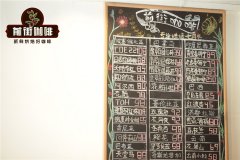Characteristics of flavor and taste of chocolate wine with various coffee beans in different producing areas of ten major coffee producing areas in Peru
Peru is rich in biodiversity. From the Amazon jungle to golden beaches, from the towering Andes to one of South America's largest lakes, it has a wide variety of landscapes and climates. The same goes for coffee. Peru is the 11th largest coffee producer in the world, but it offers more than just quantity. What's even more amazing is that it has ten different regions, each with its own unique cup flavor.

Northern Peru
To the north, Peru borders Ecuador and Colombia and has jungles, mountains and coastal areas. Northern Peru has four coffee-producing regions.
Piura is located on the Pacific coast. It is not as well known as other regions and its output is relatively low. Agriculture is concentrated in Huancabamba province, where Typica, Caturra and Catimor are the most common varieties at altitudes of 900-2,000 m.
Despite its low productivity, the coffee is balanced in acidity and rich in fermentation, with chocolate, caramel and nutty flavours.
Next to Piura you will find Cajamarca. Its largest coffee growing provinces are Jaà © n and San Ignacio, where the main coffee varieties are Typica, Caturra and Bourbon. The area is known for its sweet coffee with bright acidity and aromas of red and yellow fruits.
Cutervo region is also located here, the farm is 1600 - 2,100 meters above sea level. This new growing area has recently switched from sugar cane to coffee to meet changing demand. Varieties that can be found here include Catimor, Pache, Bourbon, Typica and a small amount of Pacamara. Most of the coffee here is vanilla, stone fruit and molasses. They have medium acidity and a balanced bouquet.
Moving northeast, we found the Amazon. In addition to being home to the most famous jungles in the world, the Amazon has seven different coffee-growing regions. As the Andes pass through the region, elevations range from 900 to 2,100 meters. The beans here have dried fruit, caramel and candy flavours, and balanced bouquet and acidity,"Anna told me. Just like in Piura, Typica, Caturra and Catimor are common. Further northeast, we come to San Martin, where coffee is produced similar to Amazonia but with a medium bouquet, with chocolate, nut and caramel flavours. "San Martin is lower in altitude, but it produces a lot of coffee," San Martin is located on the eastern slope of the Andes at an altitude of 900-1200 meters and has a tropical and subtropical climate.

central Peru
Vanuco is located northeast of Lima, in the western suburbs of the Andes, at an altitude of 900-2,000 Masr. Coffee growing areas are surrounded by forests, waterfalls, caves and flora and fauna. Typica, Caturra and Catimor are common here (along with cocoa). The characteristic flavours of coffee here can be associated with orange, citrus and caramel flavours as well as definite acidity and smooth bouquet.
Bordering Vanuco, we find Pasco, an area that includes the Amazon jungle and the Andes. Coffee production here is low, but mainly due to the climate.
The main coffee-producing areas of Pasco are Villa Rica and Oxapampa, which are high-altitude jungle areas…"she said. "Villa Rica has a nutty and sweet chocolate aroma. However, when you taste coffee, you are more likely to have raisins, fruit, citrus and floral notes, as well as clear, intense acidity and balanced body."
To the south of Pasco is the relatively large Junin district, where Caturra, Catimor and Typica are grown in the provinces of Chanchamayo and Satipo. The elevations of these two areas range from 900 to 1,800 masl.
"In these areas, especially in Satipo, their coffee is very good," Anna said. "They are very balanced coffees with black fruit, yellow fruit, strong acidity, creamy feel. They really are coffee with lots of chocolate and caramel flavor."

southern Peru
Southern Peru is where you can find the best conditions for organic coffee. It is also known for its characteristic location. In the southeast, Cusco has 900-2,000 coffee producers, which tend to grow Caturra, Bourbon and Typica. But coffee productivity is low, and the climate and soil of the region produce high-quality coffee with "red and black fruits, plums, raisins, and a very rich chocolate flavor, creamy body, and moderate acidity." Ayacucho is 1,600-1,900 meters above sea level, but also less productive than the rest of Peru. Farms tend to be concentrated in El Mar and Huanta, where cultivation is dominated by Caturra and Typica. Coffee from this region tends to have grain, black fruit, chocolate and caramel flavors, medium-bodied and moderately acidic.
Puno on the southeastern edge of Peru. It borders Bolivia at an altitude of 900 - 1,800 m Caturra, Typica and Bourbon are the most common species here. Although the region does not produce a lot of coffee, it is known for its quality. Because of his unique microclimate and variety, his coffee quality is very high. The richness of the soil results in a very complex flavor. "Puno's coffee is blended with tropical fruits like passion fruit and pineapple and tastes very juicy. They are very sweet, with caramel and molasses flavours and floral complexity. They have a juicy acidity, which means a good balance between acidity and bouquet.
Peru has a lot to offer. Its wide range of climates and elevations creates a variety of coffee flavors. From the succulent, sweet, fruity plots of Puno to the chocolates and caramels of Piura, there's something for you. So the next time you taste Peruvian coffee, pay attention to where it comes from. Maybe the results will surprise you.
Important Notice :
前街咖啡 FrontStreet Coffee has moved to new addredd:
FrontStreet Coffee Address: 315,Donghua East Road,GuangZhou
Tel:020 38364473
- Prev

How to change the concentration of coffee to improve the thickness of alcohol caffeine intensity and flavor mocha pressure pot flavor
When it comes to drinking coffee, everyone has his own personal preference. Some people like the sweet and sour taste of coffee, while I prefer espresso to give me a direct hit. This irritation actually refers to the amount of caffeine, or the flavor intensity of the coffee. If you like this strong coffee as much as I do, please read on. Caffeine and flavor are the first step
- Next

The difference between hanging-ear coffee and instant coffee the correct brewing method of hanging-ear coffee
Hanging-ear coffee is said to have been invented by the Japanese to balance the quality and convenience of ground coffee and instant coffee and to devote itself to a more meticulous coffee market.
Related
- Detailed explanation of Jadeite planting Land in Panamanian Jadeite Manor introduction to the grading system of Jadeite competitive bidding, Red bid, Green bid and Rose Summer
- Story of Coffee planting in Brenka region of Costa Rica Stonehenge Manor anaerobic heavy honey treatment of flavor mouth
- What's on the barrel of Blue Mountain Coffee beans?
- Can American coffee also pull flowers? How to use hot American style to pull out a good-looking pattern?
- Can you make a cold extract with coffee beans? What is the right proportion for cold-extracted coffee formula?
- Indonesian PWN Gold Mandrine Coffee Origin Features Flavor How to Chong? Mandolin coffee is American.
- A brief introduction to the flavor characteristics of Brazilian yellow bourbon coffee beans
- What is the effect of different water quality on the flavor of cold-extracted coffee? What kind of water is best for brewing coffee?
- Why do you think of Rose Summer whenever you mention Panamanian coffee?
- Introduction to the characteristics of authentic blue mountain coffee bean producing areas? What is the CIB Coffee Authority in Jamaica?

